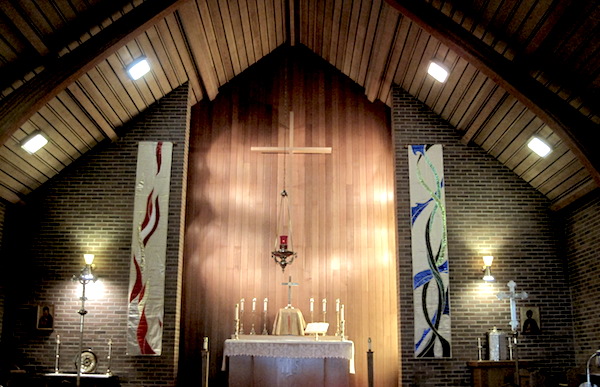 I'm sitting across from Rev. Travis Enright at the Popular Bakery. At this favourite community haunt, we are reviewing last Sunday's Sacred Space gathering at St.Faith's, led by The Bleeding Heart. And we are eating some of the city's best sandwiches.
I'm sitting across from Rev. Travis Enright at the Popular Bakery. At this favourite community haunt, we are reviewing last Sunday's Sacred Space gathering at St.Faith's, led by The Bleeding Heart. And we are eating some of the city's best sandwiches.
I have the sandwich Travis wishes he ordered. I offer to trade half of my sandwich. Now I am enjoying variety. Half house special, half ciabatta. This fusion is my best-case scenario, and it's not a bad metaphor for last Sunday's event.
When denominations dance, it can be clumsy. We can step all over each others' feet. We can stumble and fall. But if the music is just right, and we know who is leading at each moment, the dance can be beautiful. A miracle, even. But it takes listening, sensing and responding.
This past Sunday's Sacred Space at St.Faith's Anglican was a dance. There was give and take, and complicated steps to follow. There were some stumbles, but, praise God, for the most part we floated across the floor together, to the rhythms of grace.
Here is how the morning went.
The morning began with some community announcements from Travis. St.Faith's Anglican is his community and there are always house keeping items to get through. Those stood outside the service - before the dance.
Travis, from the back of the beautiful, wood-lined sanctuary, called the morning to order with a line from scripture;
"I am the resurrection and the life", says the Lord; "Whoever lives and believes in me shall never die." – John 11:25-26
From the front of the room, I began to play our first singing-song. What A Friend I've Found. The lyrics foreshadowed how our relationship with Jesus gets us through the difficult moments of life.
Next came the opening question. Or, it should have. I forgot about this, so it came later, after the Gospel reading.
The Gospel reading was a marathon. John 11:1-45. As the reader (in Anglican circles called the Gospeller) read on and on, I think we were all shuffling in our seats. 45 verses! The reading was just so long and so dense. There was so much to take from this story of Lazarus and his two sisters and Jesus and waiting and death and resurrection. Almost too much. This is why we decided to focus in on one aspect of this story for our morning – the responses of Mary and Martha to the death of their brother, and the long wait for his resurrection.
The question, what would frame the rest of our morning, was this;
When was it very difficult to wait for something?
I wasn't sure whether this would be a hypothetical question, or we would get some responses. This is the beautiful risk/reward of a liturgy that truly requires action. If people get involved, it's beautiful community. If no one gets involved, it's crickets and tumbleweeds.
People shared about waiting for a new job. Waiting for test results stands out as an answer that elicited many sighs of agreement from the congregation. It was clear that we've all waited for something, and not liked the experience.
The homily came next. I say homily because that is what Anglican's call it (I think). My tradition calls this the sermon, but then it is four times as long. David William's homily was about 10 minutes, and focussed on setting us up for how we would interact with the gospel story of Mary, Martha and Lazarus. Really, the homily and the liturgical experience to follow all fused as one central part of the morning.
Here is the text that was given to the congregation to describe the exercise.
ʻPostcard Promisesʼ Liturgy
This morningʼs liturgical experience centers around the various ways we respond to waiting, loss and pain. Martha and Maryʼs responses to the death of their brother are generalized here, in the concepts of The Head and The Heart.
Martha clings to her theological understanding - believing that Jesus can and will make this right, despite all appearances. Lazarus does already stink, after all.
Mary deals with the loss from the depths of her heart. As she begins to speak to Jesus, she breaks down weeping. He weeps with her.
These responses are overly simplified, but represent a spectrum of how we deal with loss, waiting and pain in our own lives. This morningʼs excercise explores both extremes.
The room is divided into two sides; your left represents Martha, or the response of the Head. Beliefs. Theological understanding. Reason. Your right represents Mary, or the response of the Heart. Emotions. Tears. Faith beyond words.
This morning we will spend time with both responses.
Each side of the room has the same set of promises from scripture. These are words we know to be true, but wrestle with when we face troubles. Each side of the room also has blank postcards.
In the centre of the room is a basin of water. This water represents the tears of Christ, who meets us in both responses.
MARTHA: THE HEAD (Left Side)
Read the passages on the wall, and think about one that you have experienced as true in your own life. It may take time to reflect and pray. Take your time.
Copy that passage onto the front of a blank card.
On the reverse of that card, tell the story where that passage was true for you. You can use many words or a single word. You can use images, collage or any of the art supplies provided.
Take the card with you. After this morning, you may decide to share the card with someone who needs encouragement, or keep it for to encourage yourself.
MARY: THE HEART (Right Side)
Read the passages on the wall, and select the one you have the most difficulty accepting. Which sounds hollow to you this morning? Which do you most struggle with? Take your time to reflect and pray about your choice.
Write that passage on the front of a card with the water-soluble marker provided.
Take that card and put it into the water in the centre of the room. As you watch the words dissolve in the water, think of Christʼs tears. Ask God to reveal the truth of that statement to you – to give you faith.
PRAYER
Is there a situation where you are waiting on God to act? Take a moment to pray somewhere in the centre of the room, near the basin of tears. If you like, find someone you are comfortable praying with for this need, or someone who you can pray for.
People engaged this deeply. Again, there were no tumbleweeds. No awkward silences. There was movement, all around the room. There were people writing and creating and many people gathered around the 'basin of tears', watching their wrestling dissolve into grace. Travis told me this was the most powerful image from the morning for him. On Holy Saturday, his community will take those very same cards and burn them. Knowing there was meaning in this, even beyond this Sunday, is a gift to me.
This whole piece was a reminder that people can be trusted to engage. Like any good art, I cannot control the meaning, but I can trust that people will find and make meaning if I've done my job well. It seems, in this case, that Bleeding Heart did our job well.
Next came Psalm 130. Rather than read it, I sung it, using the tune and phrasing from Seedbed, which you can access here. I like the sound of this version - it sounds mysteriously medieval to me.
From there we went into the 'St.Faith's' portion of the morning. These are elements that are critical to a Sunday morning for the St. Faith's community, and so we kept them basically in tact.
During the offering, an 'offertory' song is played. I played a song I wrote, which references Lazarus, and waiting, and pain and loss, called Miracles. The chorus promises us that,
Now's not the time for miracles Now's not the time for trap doors and way outs ... But everything comes in its time
The Eucharist, or Communion, came next. In the Anglican church this is a very set part of the service, and I appreciate the rhythm and rootedness of it. Certain words are always said. Certain songs are always sung (one called 'The Sanctus' took me a few tries to learn). There is a back and forth, call-and-response with the community. And then the community comes forth and is served, but the leadership of St.Faith's. They are given bread. They drink wine from a communal cup. They kneel and humbly receive the gift of Christ's death and resurrection. It is a powerful moment.
After communion, there is a communion hymn. I chose In Christ Alone.

Nearing the end now, Dr. Randy Ritz came to the front and read Ezekiel 37:1-14, in his inimitable dramatic style. Behind and beneath the reading were sounds of wind, and fire, and cracking bones, produced by Brook Biggin. It was a chilling moment. Interestingly, Travis Enright tells me this was different, and perhaps even difficult, for the Anglican congregation present – to just listen to the scripture and not read along. They are people of words. A normal Anglican service involves a LOT of reading.
After the reading, Travis offered a blessing, and asked me to play one final song. I hadn't prepared, but chose one that I love to play and everyone knows – a parting promise that felt right. Jesus Loves Me, This I know. Then a final sentence from Travis Enright and we were done.
All in all, it took nearly and hour and a half. It was longer than either a St.Faith's or a Bleeding Heart gathering would normally be. Some of this comes from our process of adding up to make this liturgy, rather than a true 'melding together'. I think that next time our dance could become tighter.
But it was an honour to share the dance floor with St.Faith's and their congregation this past Sunday. We worshipped God together, a varied kaleidoscope of faith's and backgrounds, in the midst of our creative community of Alberta Ave.
Like that mixed-breed sandwich, our experience has left me hungry for more.
-----
There will be more to come as to exactly how we put together an experience like this, and how you can do it with your own community. In the meantime, you might want to review our list of 11 Resources to Bring Creativity to Your Church and Your Faith.


